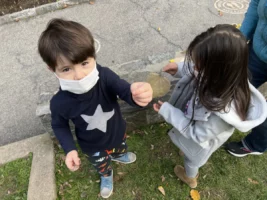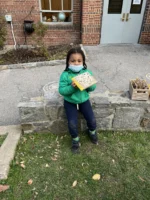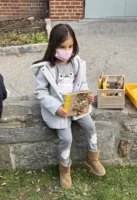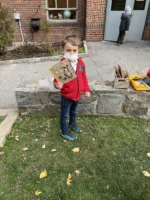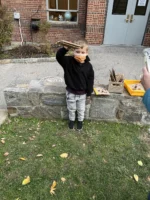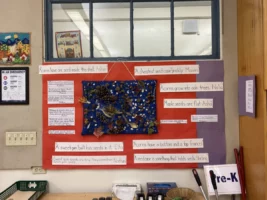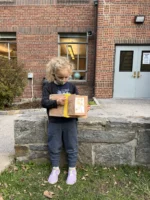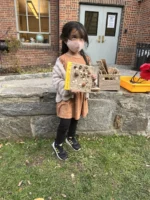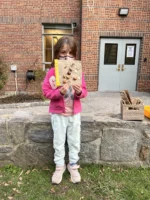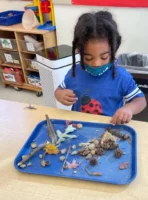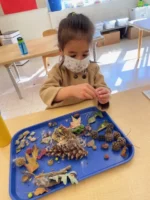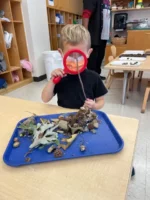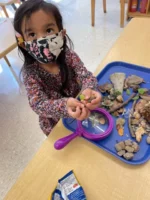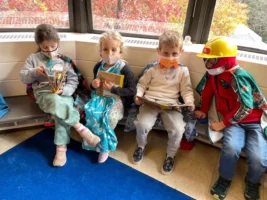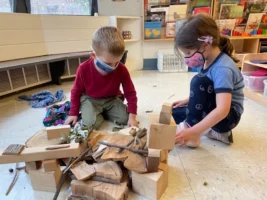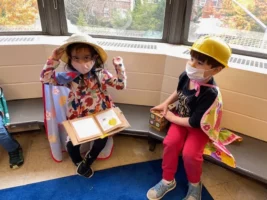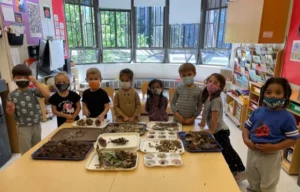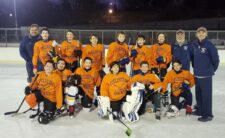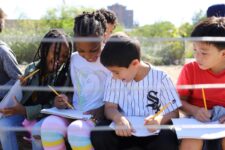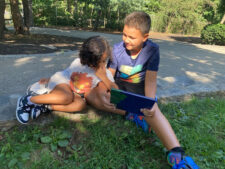It starts with a seed.
Thirty years ago, when Fieldston Lower Pre-K Teacher Cathy Burns-McDonald joined the Ethical Culture Fieldston School, she wasn’t sure what kinds of projects would keep her new students engaged. Prior to joining ECFS, Burns-McDonald worked at a school in Manhattan, and, as she says, “The city was our classroom.” Without the excitement and energy of Manhattan, what would engage her students? The answer came as soon as they stepped outside of the classroom and into the lush greenery of the Fieldston campus. Without any prompting or instruction, her students started exploring the grass, the trees, the planted gardens. The students began to notice little things of all different shapes and sizes all over the place — like confetti covering the world. They were seeds. Before long, Burns-McDonald’s students began collecting all the seeds they could find, then comparing and contrasting the varieties.
Ever curious, her students started to ask questions: Why is this seed different from this one? Where do they come from? What do seeds do? Thirty years later, her students are still searching, still questioning, and still learning all there is to know about seeds.
Much of the curriculum at Fieldston Lower is informed by nature. In Kindergarten, students learn all about butterflies and spend time observing them in both their classroom and the garden just outside their door. 1st Graders enjoy the beloved year-long bird study. 2nd Graders research bodies of water, spending time on the nearby Hudson River. Nature plays a large role in a Fieldston Lower education in part because of the scope and scale of the Fieldston campus — there are seemingly endless trees and flowers and grasses for students to enjoy and explore. For Pre-K students — much like nature itself — it all begins with the seed.
During the first few weeks of school, students explore the campus, searching for and gathering all the seeds and seed pods they can find. Through these moments of discovery, the students get to know about the campus and its natural beauty. “As we walk around, one thing that I like to point out to them, especially since they’re so little, is how the giant oak trees on campus all came from tiny acorns,” says Burns-McDonald. “They’re amazed by that.” By spending time in nature from a young age, Pre-K students cultivate an understanding of and appreciation for the natural world, preparing them to be life-long stewards of the earth they inhabit.
After spending several days collecting seeds from around campus, the Pre-K students get to sorting. This year, students found and identified twelve different kinds of seeds and seed pods, including sunflower seeds, acorns, chestnuts, and sequoia redwood seeds. By taking the time to sort through the various types of seeds, these young learners are beginning to understand basic math and science concepts: counting, sorting, observing, and identifying.
The learning doesn’t stop there. Once the seeds are sorted, the students take their observational skills to the next level: Using magnifying lenses, the Pre-K students do a close-study of each type of seed and draw a detailed picture using a specific set of colored pencils. Later in the year, when the Pre-K students draw self-portraits, they are given the exact same set of colored pencils. Burns-McDonald does this intentionally, to illuminate for the students how they, like the seeds, are all a part of nature.
Once the seed drawings are complete, the students create a book. With the help of their teacher, the students glue in their seed pictures, tape the front and back covers together — which the students design using cardboard, burlap, and actual seeds — and then bind the book using a special stapler. Even before they are able to read, Fieldston Lower Pre-K students learn not only how a book is made, but what it can do. In response to seeing their new seed books, students ask Burns-McDonald what else can go into a book: “Can I make a book about dinosaurs?” “Do things in a book need to be real?” Burns-McDonald explains that a book can contain anything they imagine. The students learn how “they can discover, construct, and communicate their own information,” says Burns-McDonald.
The seed project also provides opportunities for students to work together, from the initial excitement of showing one another their different seeds, to a final project where the class builds a large collage to hang in the room, showcasing examples of their seed collection and various facts they learned over the first few months of school. The project begins in September and wraps up just before Fall Recess. Nature is cyclical, and so too is the seed project. The last step for the students is to return all of the seeds to the campus grounds — a special Thanksgiving feast for the birds and squirrels who share the campus with them.
At Fieldston Lower, learning is rooted in exploration and discovery — and takes full advantage of the School’s sprawling, lush campus. Through the seed project, Pre-K students investigate both the natural world and their place within it. These students are at the very beginning of their educational journey, and just like the seeds they collect, they will continue to grow and flourish as learners and leaders at the Ethical Culture Fieldston School.

